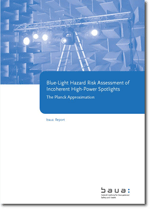Blue-Light Hazard Risk Assessment of Incoherent High-Power Spotlights
The Planck Approximation
Photochemical retinal damages caused by light with a high proportion of blue (blue light hazard, BLH) can in principle be excluded for screens, ceiling lights, smartphones, etc. upon normal viewing behavior. In contrast, high-power spotlights, e. g. in building construction and civil engineering, for events or large storage areas, can be a BLH source. Due to different built-in technologies, lamp designs, setting parameters, and exposure situations, risk assessment is demanding, not least because of the determination of radiances being required in many cases. Therefore, the aim of this project was to develop a practical, simplified BLH risk assessment method.
In order to evaluate the suitability of such an approach, the accuracy of optical instruments commonly used for risk assessment is decisive. In this respect, several broadband and spectroradiometers were investigated. Although the measurement demands were increased in three steps (radiance standard, LED Fresnel stage light, inhomogeneously emitting spotlight), the determined radiances with an approx. 5 - 12 % standard deviation were more or less independent of the source complexity. A verification of the simplified risk assessment approach, the so-called Planck Approximation, yielded an acceptable result with less than 20 % deviation.
The idea of the Planck Approximation is based on a single illuminance measurement, which is converted into BLH weighted radiance by means of the diameter of the spotlight’s front side aperture and the well-known BLH efficacy of luminous radiation for a blackbody radiator. Taking into account various influencing parameters (correlated color temperature, optical power, distance), two simple equations could be derived for maximum permissible exposure durations as a function of source size. Their usage in lab as well as at an exemplary test workplace resulted in an accuracy of approx. ±30 %.
In principle, the applicability of the Planck Approximation for BLH risk assessment can be concluded. Especially the estimation of the actual exposure conditions, among others, the cumulative duration of a direct view into the source, is of crucial importance, but commonly quite difficult to record. In this context, a simplified determination of BLH weighted radiances via the Planck Approximation seems justifiable.
Bibliographic information
Title: Blue-Light Hazard Risk Assessment of Incoherent High-Power Spotlights. The Planck Approximation
1. edition. Dortmund: Bundesanstalt für Arbeitsschutz und Arbeitsmedizin, 2022. pages: 69, Project number: F 2483, PDF file, DOI: 10.21934/baua:bericht20220825
